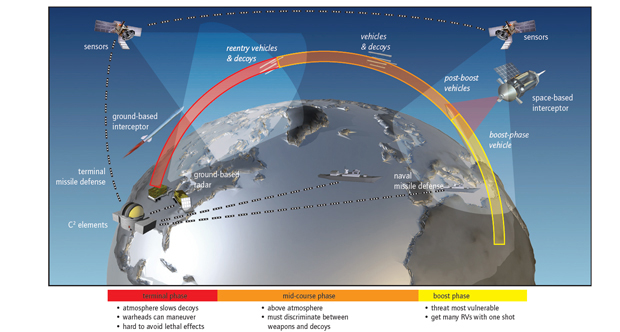Amb. Henry F. Cooper, Chairman . . . Lt. Gen. Daniel Graham, Founder
High Frontier . . Building Truly Effective Defenses . . Reagan’s Vision Lives!
E-Mail Message 130705
The Most Cost-Effective Defense: Space-Based Interceptors!
By Ambassador Henry F. Cooper
July 5, 2013
Space based interceptors are potentially the most cost-effective way to defend against ballistic missiles of all ranges more than a few hundred miles—and over twenty years ago the technology was sufficiently mature to build such a system within five years after a decision to do so. But the pathway to such cost-effective defenses is blocked by ideological concerns that masquerade behind phony arguments, such as about costs—and contrary to findings 20 years ago that have been forgotten, after the key programs were canceled in 1993. How can we go back to the future?
. . .
Without question, the most effective ballistic missile defense (BMD) system would be based in space so that its interceptors are always close to where attacking missiles could be launched. No other configuration offers much hope for intercepting ballistic missiles while their rockets are still burning as they rise from their launch pads—in their “boost phase.” This fact has been well understood since the 1960s when the Defense Advanced Research Agency (DARPA) conducted the first study on the possibility of building effective defenses against ballistic missiles.
The technical issue of whether the needed technology was available to actually build such defenses was settled, at least for me and my predecessor directors of Strategic Defense Initiative (SDI), by the late 1980s when the Brilliant Pebbles space based interceptor (SBI) system completed a rigorous series of reviews of the availability of needed technology and the associated costs for building such a system. These studies were discussed by Dr. Greg Canavan in his 2003 review of the history of missile defenses—Missile Defense for the 21st Century, published by the Heritage Foundation in the wake of President Bush’s June 2002 withdrawal from the ABM Treaty and subsequent direction to begin deploying a limited BMD system in 2004.
The technology issues were mostly settled between 1983 and 1993, as the first SDI Director, Retired USAF Lieutenant General Jim Abrahamson, and I wrote in the Journal of International Security Affairs Spring issue celebrating the 30th anniversary of President Reagan’s March 23, 1983 speech that led to the SDI. We wrote that SBIs were “an, if not the most, important product of the SDI investments on our watch. We believed then, and continue to believe now, that if the political impediments can be overcome, an effective space-based interceptor system could be deployed within five years.”
I’m sure that were he still alive, the second SDI Director, Lieutenant General George Monahan would agree. On his watch, the Brilliant Pebbles SBI system underwent the most intense scrubbing of any advanced technology program that I had witnessed during my then thirty five years in the research and development on strategic and space systems, and it was fully approved to enter the Pentagon’s formal defense acquisition activities. This season of studies is reviewed by Don Baucomb in his “Rise and Fall of Brilliant Pebbles,” along with his historical perspective of the evolution of missile defense programs as a past historian for the SDI program.
These historical reviews and perspectives by Canavan and Baucomb also testify to the little appreciated fact that such SBIs are the least costly among the options for addressing the global threat—when ballistic missiles and their launchers proliferate around the world, and might be launched from many locations on the surface of the earth. In 1988-90, the Pentagon’s Cost Analysis Improvement Group (CAIG)—now known as Cost Assessment and Program Evaluation (CAPE)—judged the cost for research, development, deployment and operations of 1000 Brilliant Pebbles for 20 years (including replacing each once) was about $11 billion in 1990 dollars.
Then Assistant Defense Secretary for International Policy Stephen Hadley and I briefed the press on February 12, 1991 on the redirected SDI program to provide Global Protection Against Limited Strikes (GPALS)—and included a consistent cost estimate. Canavan’s modeling analysis, on pages 41 of his Heritage report, yielded $12 million (I’m not sure of what year dollars)—as compared to the $11 billion in 1990 dollars (on page 55) that can be attributed to the CAIG estimates—roughly consistent with $16-17 billion in 2013 dollars.
In his review of why various missile defense programs failed in the preceding years, Canavan noted that an exception to technical failures was the 1990 vintage GPALS system (which resulted from my early 1990 critical review of the SDI program for then Defense Secretary Dick Cheney and President G.H.W Bush). GPALS had as its centerpiece the Brilliant Pebbles SBI system. In his summary comments on page 105, Canavan speculated that it failed to gain political support “because of the flawed understanding of the positive impact it could have had on stability at the time.” Regrettably, this is still the case today.
Often, this misperception and other misplaced ideological criticisms—such as concerns about “militarizing space”— are disguised by exaggerated cost estimates, rather than by a reasoned discussion of the underlying problems of achieving verifiable arms control and understanding the stabilizing role of truly effective BMD systems in the new world disorder. For example, on September 24, 2004 at the Marshall Institute, Canavan discussed the cost estimates of the American Physical Society (July 2003) and Congressional Budget Office (July 2004). He observed that the APS estimated it would be required to place in orbit 2000 tonnes (1 tonne = 2204.6 pounds) to provide a full SBI constellation—and indicated that his calculations concurred with both the APS and CBO studies when adopting their assumptions.
However, whether this constellation would provide the same coverage as the above discussed Brilliant Pebbles is unclear, but requiring 2000 tonnes on orbit grossly exaggerates what is implied by the much more credible CAIG estimates for placing 1000 Brilliant Pebbles (as then designed using 1990 vintage technology) in orbit and replacing each on over the next 10 years as part of the operations phase of the SBI constellation. This is clear from our 2009 Independent Working Group (IWG) report (pages 26-31) which provided the following summary cost estimates, as derived from the 1989-90 CAIG:
Each Brilliant Pebble (and lifejacket) on orbit was expected to weigh about 100 pounds—the IWG report says 45 kg. Thus, the total launch costs/1000 Pebbles was $400 million in 1989 dollars, inflated to $660 million in 2008 dollars. (Another 1000 Pebbles were assumed to be deployed at the same unit cost for replacement purposes during the designed 20-years of operations.) Launching 2000 Brilliant Pebbles over 20 years, each weighing 100 pounds, corresponds to placing 100 tons on orbit = 90 tonnes or less, than 1/20 of the APS/CBO grossly exaggerated on-orbit weight estimates, with corresponding exaggerated cost estimates.
The IWG report also references the above Canavan study for the Marshall Institute and noted that he found that the actual Iridium launch costs/pound were slightly less than the CAIG estimates for Brilliant Pebbles. (Iridium is a proliferated satellite communications system developed—using some Brilliant Pebbles technology, by the way—and deployed by Motorola in less than 5 years for about $5 billion.)
Such exaggerated launch cost estimates are associated with the much greater weight assumed to compose each Brilliant Pebble and its Life Jacket than was the Brilliant Pebble designed by the SDI team, reviewed by the OSD acquisition authorities and costed by the 1989-90 CAIG—and which was being actively developed by two contractor teams (TRW/Hughes and Martin Marietta) when the program was canceled in 1993 by the Clinton administration. Today, the technology has advanced by several generations and even lighter SBI should be possible—with correspondingly lower launch costs, which 20 years ago were estimated to be less than ten-percent of the total system costs for research, development, deployment and operations of the full system for 20 years.
As illustrated in the above figure, such a defense would provide multiple intercept opportunities, beginning in an attacking missile’s boost phase while its rockets still burn; then in its midcourse phase while it arcs upward toward its apogee and downward into the earth’s atmosphere; and even at high altitudes as it penetrates the atmosphere and continues its flight toward its target. No other single system can make this important claim.
For example, to assure that all possible launch areas could be covered by a deployment of our sea-based Aegis BMD ships—the next most cost-effective way to get wide area defense coverage, defenses on many ships would be required, and they could not provide the desired boost- or ascent-phase defense in many cases because they cannot get close enough to threatening launch areas. And in the midcourse phase, the sea-based interceptors may be overflown before the attacking warhead heads back downward—where in the late midcourse stage they again can intercept the attacking missile—at least until it begins to reenter the earth’s atmosphere.
Bottom Line.
We have known for over two decades that the most cost-effective BMD system would be based in space—just as President Reagan anticipated when he launched the SDI program over 30 years ago. But for two decades, there has been no development of this most effective defense, even though the technology was sufficiently mature in 1990 to begin serious development. The problem is neither an absence of technology nor the cost of building that defense—it is purely political in nature, and, until an ideological resistance is dealt with, the American people will be denied the best defenses against ballistic missile attack that money can buy. So, how do we go back to the future?
What to do?
That’s a really tough question in the current political environment.
Oh, for another Ronald Reagan—or at least a critical mass of individuals who understand our vulnerabilities and the possibilities of today’s technology—indeed even twenty year old technology—and who are willing to engage “the powers that be” to use the best technology we have to provide for the common defense as they are sworn to do!
In any case, we at High Frontier will continue to inform the powers that be of the existential threat associated with electromagnetic pulse (EMP) and how it can be countered—including by space-based defenses if we can address the afore-mentioned ideological and political problems. With all the bad news from the Middle East and North Korea, we may need the most effective defenses we can build relatively soon.
For example, if you care about the threats from the South we have written about recently, satellites from North Korea and Iran carrying nuclear weapons could possibly overfly the defenses we could currently deploy in the southern hemisphere—but not a space based defense.
We will couple these concerns in our efforts to inform the powers that be in Washington and urging grass roots Americans and local/state authorities to get involved in learning about the issues and responding accordingly. As we wind down our celebration of our nation’s founding, we owe this to our posterity.
And what can you do?
Join us at High Frontier in seeking to alert the public and your local and state authorities to the existential threats posed by both man-made and natural EMP events—and what can be done about these threats.
We can use your help in spreading this information to the grass roots and to encourage all “powers that be” to provide for the common defense as they are sworn to do. Will you do your part?
Begin by passing this message to your friends and suggest they visit our webpage, www.highfrontier.org for more information. Also, please encourage your sphere of influence to sign up for our weekly e-newsletter!
Please click here to read Past Weekly Udpates!
Please click here to read past Flash Messages!
Please help High Frontier continue this important and timely work!
Be sure to follow us on our Social Sites!
If you found this letter via our Social Sites, and you would like to subscribe, click below!








